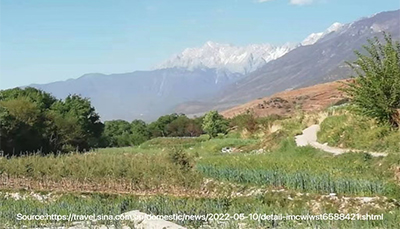



Source:https://travel.sina.com.cn/domestic/news/2022-05-10/detail-imcwiwst6588421.shtml
At the 2022 annual meeting of the Boao Forum for Asia, which was held recently, the news that China will establish a new batch of national parks this year in the Qinghai-Tibet Plateau, the Yellow River Basin, the Yangtze River Basin and other regions with important ecological locations and good ecological functions, which has attracted great attention.
Since the establishment of the first batch of national parks, what achievements have been made in ecological protection? What are the protection priorities of the second batch of national parks? How will China achieve the goal of building the world's largest national park system? The reporter interviewed Tang Xiaoping, president of the National Park Research Institute.
Since the official establishment of the first batch of national parks, the value of ecological assets and ecological services has been increasing.
Reporter: In October 2021, China officially established the first batch of national parks including Sanjiangyuan, giant pandas, Siberian tigers and leopards, Hainan tropical rain forest, and Wuyi Mountain. Since its official establishment, what achievements have been made in the construction of the first batch of national parks?
Tang Xiaoping: A national park is a beautiful business card showing the beauty of China's nature and culture, and it is also the most important ecological protection area for a country. The first batch of five national parks officially established, with a protected area of 230,000 square kilometers, covers nearly 30% of the national key protected wildlife species in China's land area.
Since its official establishment, the first batch of national parks has achieved remarkable results in ecological protection, and the value of ecological assets and ecological services has been enhanced. For example, Sanjiangyuan National Park, which has strengthened ecological governance at the source, reproduces the beauty of Qianhu Lake; Giant Panda National Park connects more than 60 existing nature reserves by enhancing the integrity and connectivity of the national park; Northeast Tiger and Leopard National Park found that the habitat of tiger and leopard populations has spread significantly last winter and this spring by monitoring. The number of Siberian tigers has increased to about 50, and the number of Siberian leopards is about 60. Hainan Tropical Rainforest National Park has innovated the dual management mechanism of comprehensive law enforcement and stationed, which effectively strengthens the natural resource asset management and protection; Wuyishan National Park organically combines ecological protection with the increase of residents' income through franchising and other mechanisms.
Reporter: In order to enhance the value of ecological assets and ecological services, what tasks have China focused on?
Tang Xiaoping: Since the establishment of the first batch of national parks, in accordance with the establishment plan approved by the State Council, we have cooperated with various departments and territorial provinces to continue to advance the work in four areas:
The first is to organize the preparation and approval of the overall plan. Make arrangements for the first batch of national parks in the next 10 years to further set management goals and main tasks, and standardize the operation mechanism.
The second is to promptly establish a unified, standardized and efficient management organization for the five national parks in accordance with the requirements and guidance of the Central Office, which will serve as the main body of ecological protection and management in the future.
The third is to redefine the deployment and construction of ecological protection and management infrastructure. Adopt modern technology, optimize and upgrade the existing infrastructure of each national park, build an integrated monitoring and supervision system of sky and ground, and strictly protect the ecology of the entire national park. At the same time, improve the public service facilities and enhance the scientific research, education and recreational functions of the national park.
In addition, during the pilot period of the national park system, some effective management systems will gradually rise to the legal level, forming an institutional system for closed-loop management of the whole process. At present, the law on nature reserves and legislation on national parks are advancing in an orderly manner. Before the official promulgation of laws and regulations, the State Forestry and Grassland Administration is promoting the introduction of interim measures for the management of national parks as a management basis for the transition period to ensure that the construction and management of national parks have laws to abide by.
The list of a new batch of national parks is being prepared, and there are many factors for selection.
Reporter: Combined with the construction experience of the first batch of national parks, what are the conditions for a selected national park?
Tang Xiaoping: The main purpose of national parks is to protect nationally representative natural ecosystems, to achieve scientific protection of natural resources and rational use of specific land or sea areas. Protecting the integrity and authenticity of ecosystems in the form of national parks is of great significance for maintaining national ecological security, protecting biodiversity, preserving natural heritage and improving the quality of the ecological environment.
China is extremely cautious when setting up national parks, and there are many considerations for the selection. The key consideration is that the pilot areas of the national park system have already been carried out, but there are several pilot areas that have not established national parks in the first batch, such as Shennongjia, Qianjiangyuan, Pudacuo, Nanshan, Qilianshan, etc, which we are familiar with. These five pilot areas are currently undergoing rectification and optimization in accordance with third-party evaluation opinions.
Some ecologically important or ecologically fragile areas will be preferentially included in the national park system. This is also an important consideration for the establishment of a new batch of national parks in areas such as the Qinghai-Tibet Plateau, the Yellow River Basin, and the Yangtze River Basin.
Ecological areas with high international or domestic attention may also be the focus of the new round of national parks. For example, the return of Asian elephants from the north to the south has attracted widespread attention at home and abroad last year. Now the State Forestry and Grassland Administration and the Yunnan Provincial Government are also actively promoting the protection of important habitats and concentrated distribution areas of Asian elephants. In the future, it’s possible to establish a National park of Asian elephant in the name of the animal’s type.
In terms of sea area, China's East and South Seas are rich in biodiversity, and the construction of marine national parks will also be a focus in the future. From the perspective of management feasibility, the waters of Long Island may become the entry point for the construction of marine national parks.
Strictly protect the most important natural ecosystems, the most unique natural landscapes, the most essential natural heritage, and the areas with the most biodiversity.
Reporter: Since the Establishment of a National Park System was firstly proposed in 2013, what stage is China’s national parks currently in after nearly 10 years of construction and development?
Tang Xiaoping: After the strategy of establishing a national park system was put forward, in accordance with the concept that mountains, rivers, forests, fields, lakes, grass and sand are a community of life, China breaks administrative boundaries and divisions, innovates management systems and mechanisms, and incorporates important nationally representative natural ecosystems into the country. The park system is strictly protected. Since 2015, our country has successively launched 10 national park system pilots. This stage will basically come to an end with the completion of the evaluation and acceptance of the pilot areas in 2020. On October 12th, 2021, President Xi Jinping announced the official establishment of the first batch of 5 national parks at the 15th COP Leaders Summit of the Convention on Biological Diversity. The construction of national parks has laid a solid foundation. Completing the task of building high-quality national parks is a long-term and gradual process. The quality of building national parks is not based on quantity, but is gradually advanced by adhering to the principle of establishing a new one when one is matured, and meanwhile promoting the improvement of the system and mechanism and achieving true maturity and quality.
Reporter: What would a high-quality national park look like? How will China promote the construction of the national park system?
Tang Xiaoping: A high-quality national park should be a concentrated expression of the most important ecosystem, the most unique natural landscape, the most essential natural heritage, and the most abundant biodiversity. While strictly protecting the relevant areas, it should provide a platform for the whole people to share.
The construction of the national park system is a systematic project. Firstly, we must do a good job of top-level design, form a plan for the spatial layout of national parks, and answer the questions of how many national parks will be built in the future and where they will be built. Focusing on solving this problem, we set up access thresholds for national parks mainly from three aspects: national representation, ecological importance, and feasibility of establishment. At present, five national standards, including the Regulations for the Establishment of National Parks, run through the entire management process of national park establishment, planning, boundary demarcation, monitoring and evaluation, providing important support for building a unified, standardized and efficient national park system with Chinese characteristics. After the standards are clarified, the next step is to coordinate national land and space planning. Through the overall assessment of the national ecological status, areas with national representatives, rich scientific connotations and rich biodiversity will be selected, and national park areas will be preferentially reserved in the national land and space planning outline, and the three districts and three lines of territorial space planning will be well connected to ensure that important ecological spaces are protected.
The concept of national parks should not only insist on ecological protection and national representation, but also public welfare for the whole people. At present, the State Forestry and Grassland Administration is working with relevant departments, local governments, and all sectors of society to promote the high-quality construction of national parks and jointly build the world's largest national park system. This construction process is a process of continuously satisfying the people's yearning for a better life.
The establishment of the national park system in our country is relatively late, and the development and construction time is very long, and it is bound to face some contradictions between protection and development. Therefore, before setting up a national park, it is necessary to sort out these examination questions one by one, or resolve or transform or integrate. For example, in Wuyishan National Park, the most complete, typical and largest central subtropical native forest ecosystem in the same latitude zone in the world is preserved. There are thousands of aboriginal residents here. After the pilot project of the national park was launched, the local people are also guiding the public to participate in the ecological protection work. Ecological stewards, interpreters, and law enforcement team members have all become new jobs for these aboriginal residents.
Source:<http://www.planning.org.cn/news/view?id=12534&cid=15>
Translated by Wang Yue